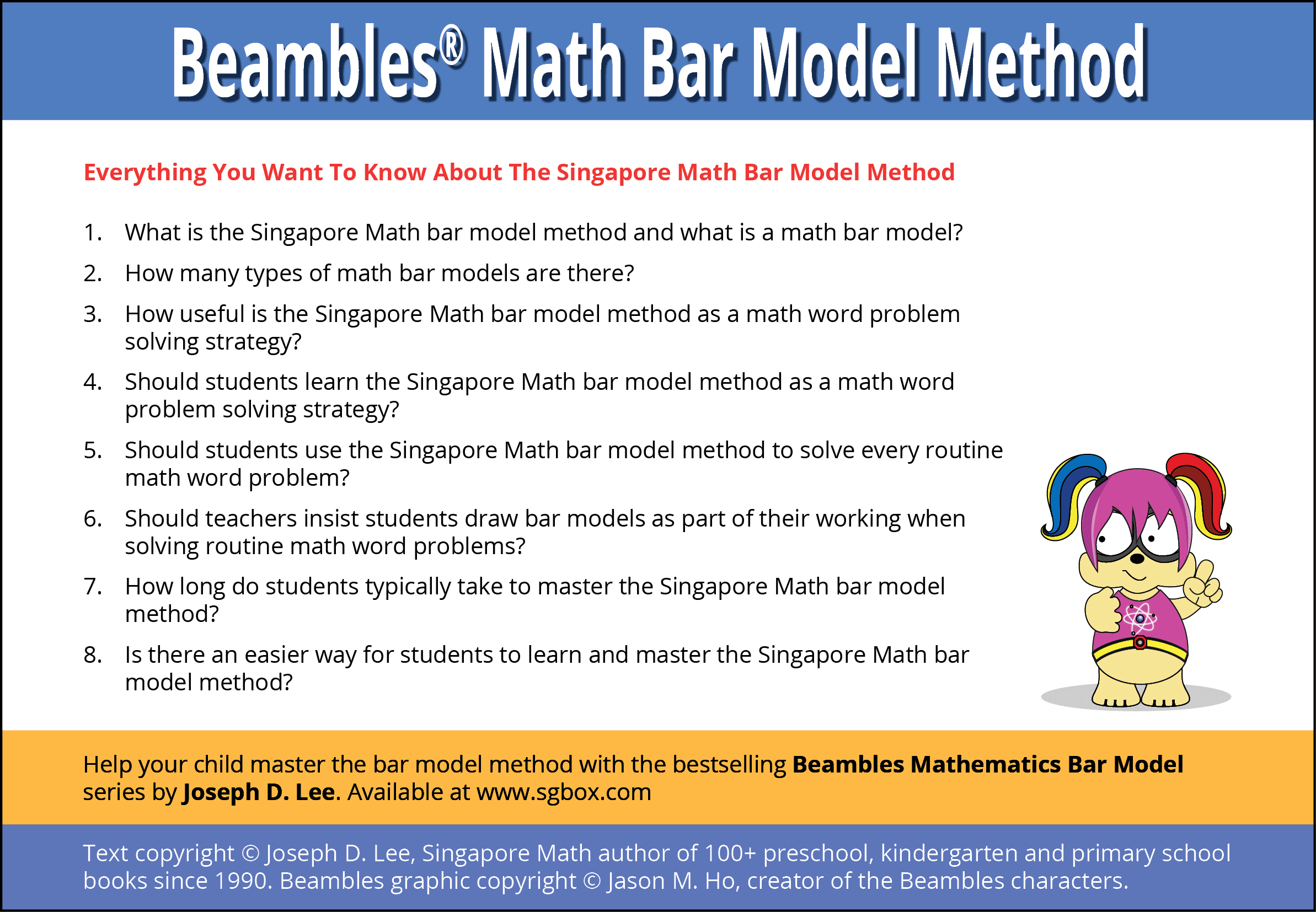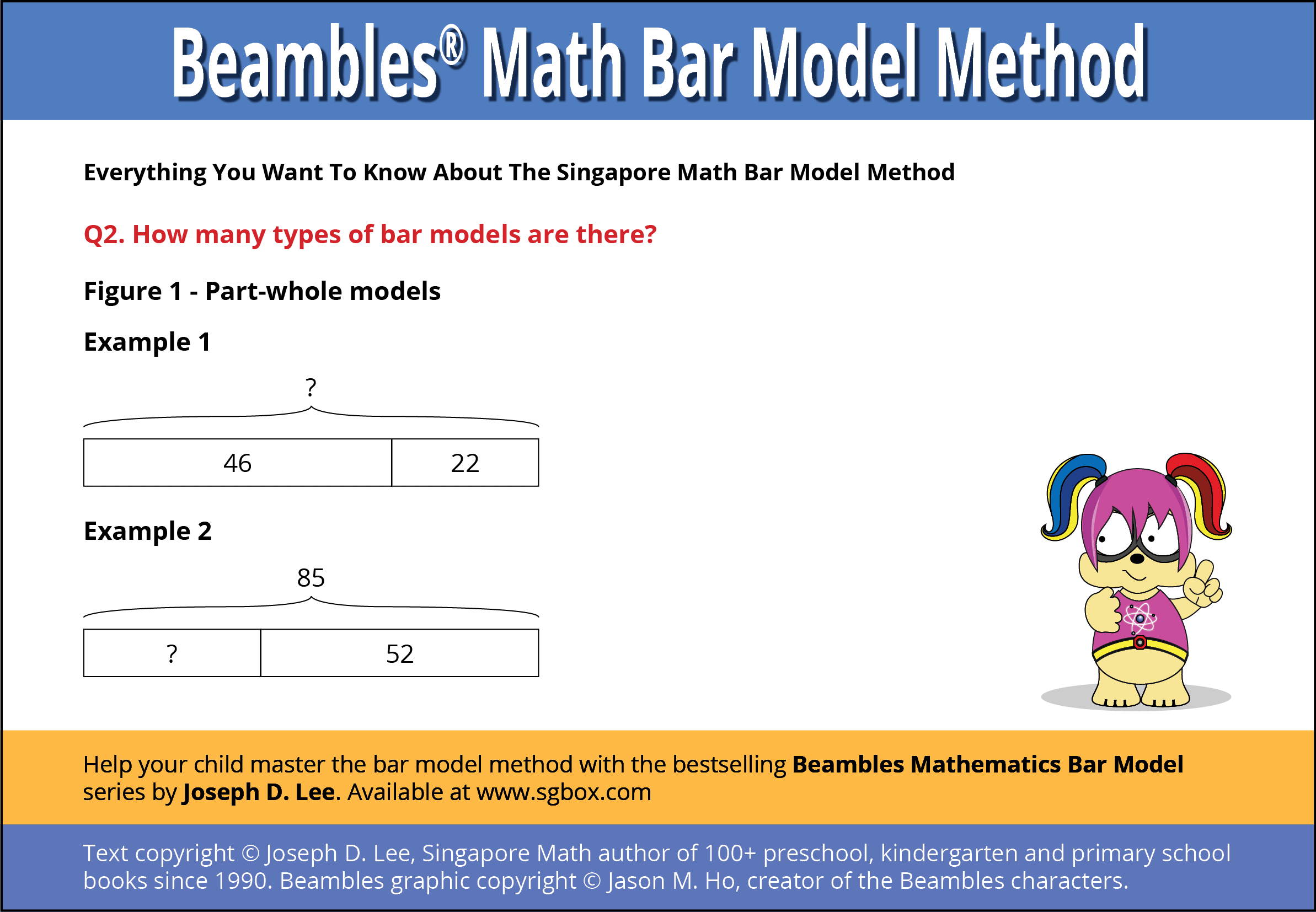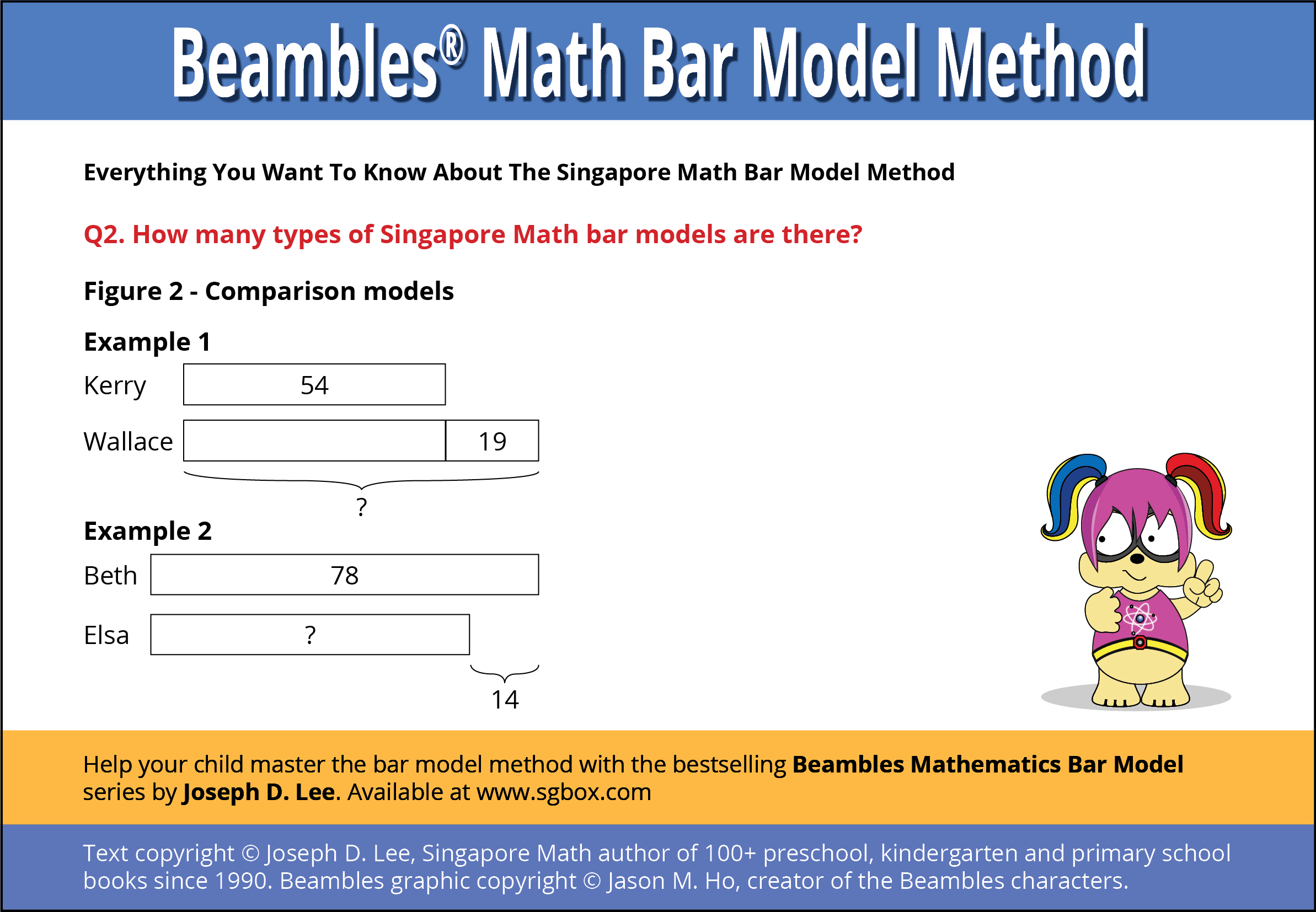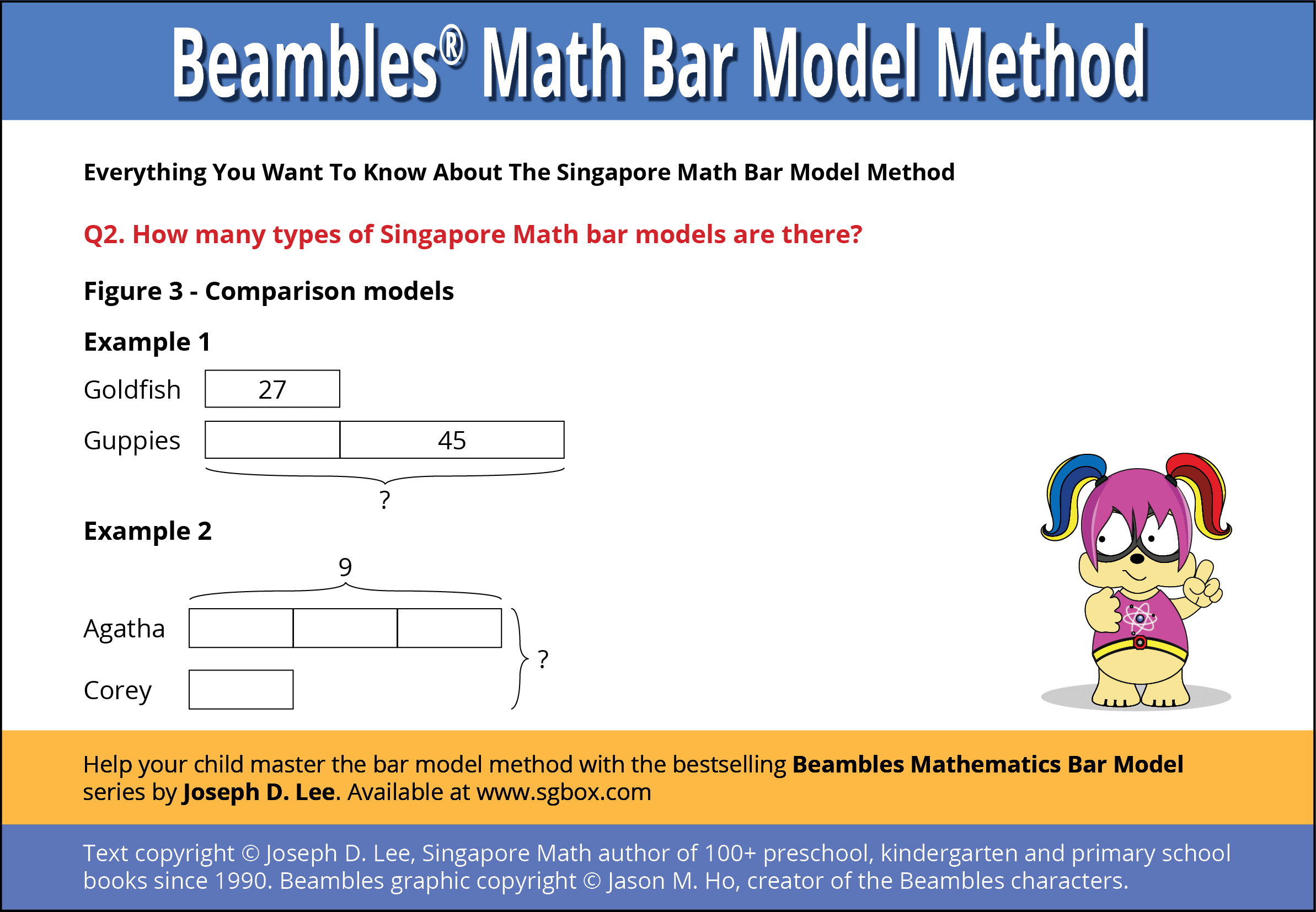Home > Resources > Singapore Math Resources > |
8 Questions Answered About The Singapore Math Bar Model Method
Copyright © Joseph D. Lee, author of 100+ Singapore Math books since 1990
1. What is the Singapore math bar model method and what is a math bar model? The Singapore math bar model method is a popular math problem solving strategy taught in Singapore primary schools. A math bar model allows the teacher to create a standard visual representation of many types of routine math word problems when explaining them to students in a classroom setting. It is a useful tool to help students understand and interpret a routine math word problem, restate the important information given in the math word problem, find out what the math word problem is asking for, and then devise one or more mathematical equations to solve it. 2. How many types of math bar models are there? There are two general types of math bar models. The first type of math bar models is a part-whole model as shown in Figure 1 below, which normally consists of a bar that is made up of two or more parts, arrows, identifiers (e.g. names), numbers and a question mark. A part-whole model is usually used to solve non-comparison routine math word problems involving a single mathematical operation, i.e. addition, subtraction, multiplication or division. The second type of math bar models is a comparison model as shown in Figure 2 below, which normally consists of two or more bars, arrows, identifiers (e.g. names), numbers and a question mark. A comparison model is usually used to solve comparison routine math word problems involving one or more mathematical operations. Sometimes, one or more of the bars in a comparison model may comprise two or more parts as shown in Figure 3 below. 3. How useful is the Singapore math bar model method as a math word problem solving strategy? The Singapore math bar model method has proven to be a very useful math word problem solving strategy in as far as a math word problem can be represented as a math bar model, which is to say it is very useful in a wide range of routine math word problems that can be solved by means of one or more mathematical equations. However, it is not a suitable tool when solving non-routine math word problems whose solutions cannot be readily reduced to a series of mathematical equations. 4. Should students learn the Singapore math bar model method as a math word problem solving strategy? Yes, students should absolutely learn the Singapore math bar model method as a math word problem solving strategy. One of the main goals of the study of Mathematics is to help students develop problem solving skills, and they should be equipped with as many useful math problem solving strategies as possible. The Singapore math bar model method is a very handy math problem solving strategy, especially when solving complicated multi-step routine math word problems. In addition, it has been proven that students who are well versed with the Singapore math bar model method understand and master algebra more easily than those who are not. This is not surprising given that the parts and units in math bar models are essentially the visual equivalents of algebraic variables. 5. Should students use the Singapore math bar model method to solve every routine math word problem? No, students should definitely not be compelled to use the Singapore math bar model method to solve every routine math word problem. This may sound like a contradiction to the above paragraphs, but it is not. Students should be taught the Singapore math bar model method to solve routine math word problems so that they can learn how to use it to solve routine math word problems. However, once they are familiar with it and have developed the mental capacity to solve routine math word problems by devising mathematical equations without having to draw a math bar model, they should be encouraged to do so. This is akin to the case of the more abled students who can solve multi-step routine math word problems with a single long mathematical equation instead of multiple single step equations. Teachers should be delighted when their students can solve routine math word problems without having to draw a math bar model after they have mastered the Singapore math bar model method, just like when their students can solve routine math word problems with a single long mathematical equation, as it means their students have made good progress in their acquisition, mastery and development of math word problem solving skills. 6. Should teachers insist students draw math bar models as part of their working when solving routine math word problems? The short answer is yes and no. Initially, when students are learning how to draw math bar models to solve new types of routine math word problems in a new math topic at their grade level, teachers should insist they draw a math bar model as part of their working when solving each routine math word problem. This is to ensure that students have ample practice in drawing math bar models. It also provides feedback to teachers on whether their students understand each math word problem perfectly and whether they know how to draw math bar models correctly. However, students should not be compelled to draw math bar models when solving routine math word problems in their math tests and other assessments where time is of the essence if they can solve them without drawing math bar models, unless ample time has been allocated for drawing the math bar models or unless it is an assessment focusing on their math bar model drawing skills. 7. How long do students typically take to master the Singapore math bar model method? Depending on their grade level and capabilities, the type of math word problem, the amount of practice and the amount of effort they put in, a student can take as long as it takes. Firstly, it should be noted a student who is learning how to draw math bar models for the first time may take quite some time to acquaint themselves with them. Secondly, a student who has mastered the Singapore math bar model method when solving a particular type of routine math word problems based on a particular math topic would need time to learn how to use the Singapore math bar model method when solving a different type of routine math word problems based on the same math topic. Thirdly, a student who has mastered the Singapore math bar model method when solving a single-step routine math word problem based on a particular math topic would need time to learn how to use the Singapore math bar model method when solving a multi-step routine math word problem based on the same math topic. Fourthly, a student who has mastered the Singapore math bar model method when solving routine math word problems based on a particular math topic, e.g. addition with whole numbers, would need time to learn how to use the Singapore math bar model method when solving routine math word problems based on another math topic subtraction, e.g. subtraction with whole numbers. As you can see, learning and mastering the Singapore math bar model method is an ongoing process as a student progresses from a math topic to another and from a grade level to another. 8. Is there an easier way for students to learn and master the Singapore math bar model method? Yes, there is an easier way for students to learn and master the Singapore math bar model method. The following Beambles Mathematics Bar Model Method series of books is specifically designed to teach your child how to solve mathematics word problems using the Singapore math bar model method step by step, so as to help them develop and enhance their problem solving skills.
Each chapter in each book is divided into two sections and lessons - Part-Whole Model and Comparison Model. Each section will teach your child how to identify, recognise and solve a wide range of mathematics word problems based upon each topic that can be solved using the respective part-whole model / comparison model and how to apply it accordingly. Together, these two sections will teach your child how to solve the various types of mathematics word problems using the Singapore math bar model method.
|
Content Copyright © 1997 - 2024 SGBox. All rights reserved. Powered by Sellsa. |









